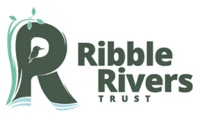Ribble Rivers Trust is a Clitheroe based environmental charity who work closely with local communities to protect and restore rivers for the benefit of wildlife, landscapes, and people. Over the next five years, we’re planning a range of projects to improve river health, reduce flood risk, and strengthen the resilience of local communities across the Ribble Catchment. One area that we’ve identified as a priority location for improvement works is Waddington Brook.
WHAT’S HAPPENING IN WADDINGTON
Ribble Rivers Trust are a science and data led organisation, and we have been exploring the information, data and evidence we hold about the aquatic biodiversity of Waddington Brook. This has helped us to identify two challenges: the brook is presenting a significant flood risk to the village, and it’s not as healthy for fish and other wildlife as it could be.
Our first step in improving the brook is to help fish move more freely through the village. Currently, two weirs on the brook are preventing migratory fish species like European Eel, brown trout, and Atlantic salmon from reaching their upstream spawning grounds. This disrupts the natural life cycle of fish and has secondary impacts on other aspects of river health.

However, the solutions to these issues must also preserve the historic character of Waddington. So, the Trust are focussing on an option that will complement, rather than completely change these features, whilst also aiding these species in this important part of their life cycle.
Rather than removing the weirs, we’re proposing the installation of rock ramps, which are natural-looking features that gently guide fish upstream while blending in with the existing environment. These ramps are designed to complement the appearance of the brook, maintaining its heritage while improving biodiversity. To help the community envisage what this looks like, we would have had artist impressions created.


LOOKING AHEAD: COMMUNITY- LED FLOOD RESILIANCE
While our fish passage plans are the first step, they’re just the beginning of a broader vision for Waddington Brook.
Over the next few years, we want to work directly with residents to create a Waddington Catchment Action Plan. This will be a community-led roadmap for reducing flood risk, improving water quality, and boosting biodiversity. As a community lead project, this means that you get to shape the priorities and solutions that work best for your area, with Ribble Rivers Trust supporting you every step of the way.
We’ll provide the evidence and expertise, and you’ll help guide the actions which could include creating and restoring habitats such as wetlands and woodlands, reducing surface runoff and storing excess rainfall, or finding creative ways to keep homes and gardens safer from flooding. Through this more sustainable mechanism, voluntary community groups will manage and maintain delivery in the future.
UPDATES ON FEEDBACK RECEIVED SO FAR
- Fish pass locations and stepping stones: The stepping stones will be retained. They were removed from the artist’s drawing so the illustration could clearly show how the fish pass will look. Ribble Rivers Trust is only proposing to work on the weirs themselves, located at grid references SD 72911 43749 and SD 72897 43837.
- Flood risk responsibility: Ribble Rivers Trust is a conservation charity. We do not have statutory powers, direct funding, or formal responsibilities in relation to flood risk. Responsibility lies with the County Council, Borough Council, and the Environment Agency, each of which has different duties. With limited resources, these bodies are not always able to address flood risk everywhere.
- Natural Flood Management (NFM): Wherever possible, Ribble Rivers Trust combines activities to deliver multiple benefits, including reducing flood risk. For example, tree planting and wetland creation can improve water quality, create new habitats, and help reduce downstream flooding. So, whilst we do not receive direct funding for traditional, engineered flood risk management, by combining activities, we can help address flood risk. However, our resources are limited, and we are actively seeking ways to increase the scale and impact of our work across the Ribble Catchment.
- Community Catchments: This project is currently being trialled in Ribchester, and we are keen to expand it to other communities. Community Catchments provide local people with our support and guidance, enabling them to take action themselves to improve their streams through actions such as reducing flood risk, improving water quality, or enhancing habitats.
- The Duck Race: This won’t affect the duck race! We usually conduct in-river works later in the year, when river levels are lower.
SHARE YOUR THOUGHTS
We’d love to hear your ideas, concerns, or questions about the proposed fish passage works, or the Waddington Catchment Action Plan. Whether you want to stay informed, ask a question, or get involved, just submit your response below.

Rivers are at the heart of our local landscapes. Whether you’re casting a line, exploring a riverside trail, or simply basking in the beauty of nature, you can help protect these special places now, and for generations to come.
By becoming a Ribble Rivers Trust supporter for just £3 a month, you’ll be funding real, on-the-ground action.
Ready to make a difference? Learn more here: ribbletrust.org.uk/become-a-supporter

